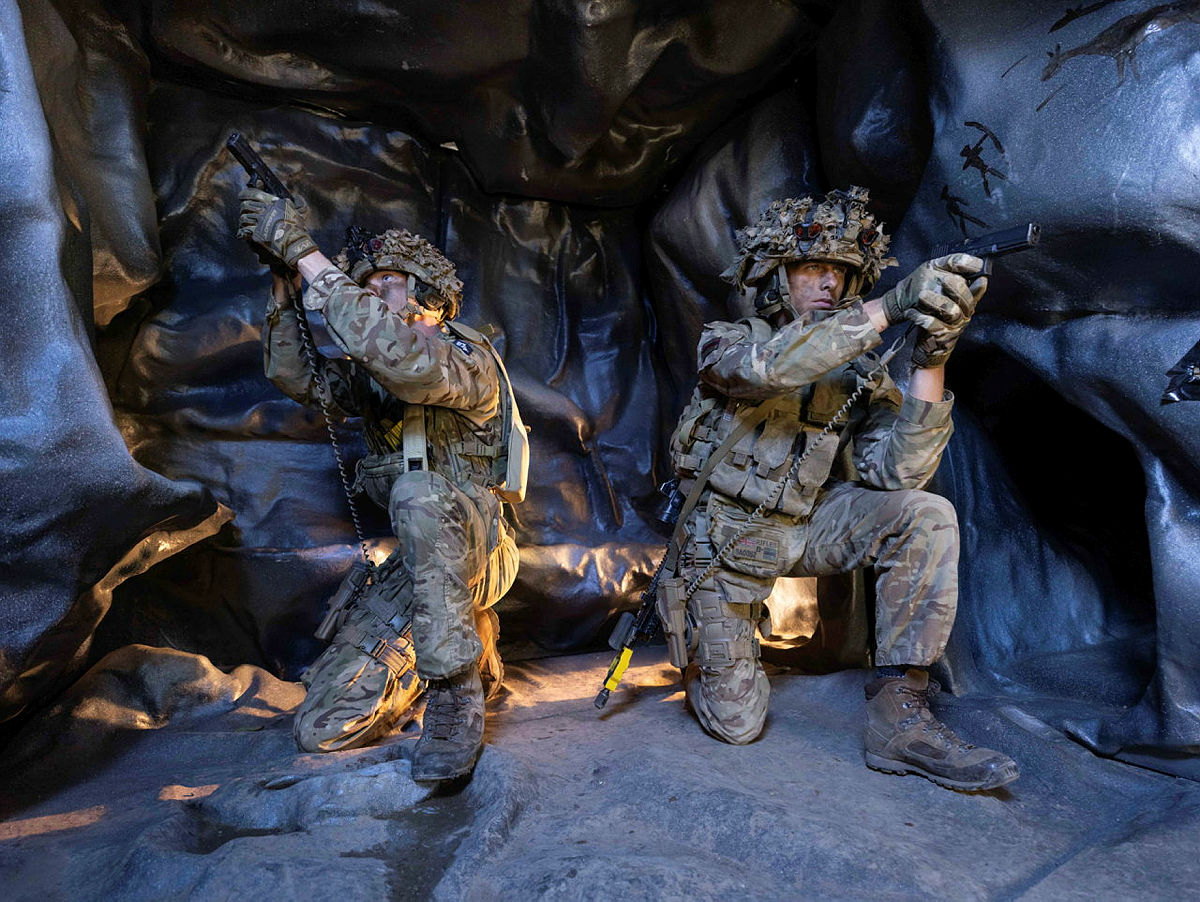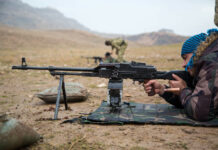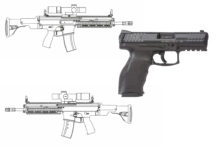In principle designing a modern military pistol ought not to be that challenging, after all, you are not inhabiting an area that might be described as the high end of high technology! All of the basic principles of effective pistol design are well understood, advances in materials technology offer all sorts of interesting possibilities in terms of frames and moving parts, while computer-aided design and manufacture ought to simplify the task of delivering the ‘ideal’ military pistol. Yet despite considerably more than one hundred years of designing, developing and producing ‘modern-style’ military pistols, there have been some surprisingly bad designs which have entered the marketplace.
Pistols are an area in which simple has become very difficult to get right for many users and manufacturers! On the other hand, military customers can benefit from the fact that there are a vast number of pistols out there that could meet all sorts of proposed requirements and within that ‘vast number’ of pistol designs there are some seriously high quality pistols that can really deliver the desired performance in all of the standard military pistol scenarios. Then there are the other factors, many of them subjective, that influence perceptions of how good a particular pistol is. In that context one would do well to remember the US love affair with the .45 calibre pistol cartridge (11.43×23 mm) and the Colt M1911 pistol, a combination that has remained in service with the US military for more than seventy years.
Another pistol that earned itself a place in the pantheon of classic pistol designs is the Luger, designed by Georg Luger (1849-1923). For all of his contributions to German small arms design, Luger was actually an Austrian, born in the Tyrol region. Hugo Borchardt designed the C-93 semi-automatic pistol in 1893 in a new 7.65×25 mm Borchardt cartridge loading, Luger became involved in the marketing of this pistol and then his involvement grew to work on modifications and enhancements to the pistol. The saw the development of a new cartridge 7.65×21 mm, later known as 7.65 mm Luger, and eventually a whole series of other evolutionary developments that the resulted in what we know today as the Luger pistol.
The first customer for the Luger pistol was Switzerland who adopted the weapon in 7.65 mm Luger as the Pistole 1900, a second variant was the Pistole 1900/06, initially manufactured by DWM in Germany and later by Waffenfabrik Bern (W+F Bern). A further improved variant was the 06/29 and this was manufactured by W+F Bern from 1929 onwards. The Luger remained the frontline Swiss military pistol until replaced by the SIG P210 at the end of the 1940s, but the Luger remained in Swiss second-line service as late as the 1960s.
The enduring legacy of Georg Luger surprisingly was not his eponymous pistol, but rather ammunition. The Imperial German Navy liked the Luger pistol, but was not too keen on the 7.65 mm round. Consequently, Luger designed a new round based on the 7.65×21 mm cartridge, which resulted in the 9×19 mm Parabellum, also called 9 mm Luger, which arrived in 1902. The Navy adopted the 9 mm pistol in 1904, with the German Army adopting the pistol in 1908. What is really significant today, is that the Luger 9×19 mm round is a standard NATO round and remains the dominant military pistol calibre. As an aside, the Luger took part in the US Army pistol trials that led to the selection of the Colt M1911, initially in 7.65 mm Luger and then in .45 calibre, using US-supplied ammunition, most of which was faulty, forcing the German manufacturer DWM to configure its own .45 rounds for the US trials.
The legacy of Georg Luger in pistol design lives on through 9×19 mm ammunition. However, it is worth remembering that another major figure in small arms development in the form of John Moses Browning (1855-1926), who was responsible for the design of the Colt 1911. Outside of his work in the US, Browning had a major relationship with FN in Herstal, Belgium, and FN Browning pistol designs included the M1900, the M1903, and the M1910/M1922 as well as the design for the Hi-Power pistol, which has been incredibly significant in terms of military pistols. Indeed, Browning was with FN Herstal when he died in November 1926.
Industrial Background
Over the years Europe has found itself blessed with what might be described as an overabundance of pistol manufacturers seeking to access military, paramilitary and law enforcement markets. Initially this large industrial base grew for a requirement to replace or perhaps look beyond the revolvers that had been dominant in the pistol market. In the early years of the modern pistol, the basic principles of design and engineering were relatively easy to master, resulting in a profusion of designs. Many of these had merit, others were less than satisfactory.
At the beginning of the twentieth century, advances in materials, ammunition design, chemistry and related disciplines provided the basis for successful pistols. Added to which, there was a more laissez-faire attitude to gun ownership for private citizens, creating a significant domestic pistol market. Even today, the significance of private gun ownership in providing a major market for pistol manufacturers cannot be underestimated. While such a market does not exist in Europe, access to the US market has proven essential for European manufacturers.
Inevitably, industrial consolidation has reduced the number of European pistol manufacturers, but there is still a very strong European industrial base in this sector. There are the traditional names such as Beretta, FN, Steyr, Walther, as well as names of more recent provenance such as the CZ Group, Radom in Poland (currently operating as FB Łucznik Radom), Heckler & Koch, SIG and, of course, Glock. On top of that, pistol designs have emerged in numerous Eastern European countries such as Bulgaria, Croatia, Montenegro, Serbia and the Ukraine amongst others. If your horizons were broadened to include US-manufacturers, then it is fair to say that any reasonable pistol requirement could be met with little difficulty. Look elsewhere and modern pistols can also be acquired from Israel, Brazil, the Republic of Korea, China, Russia, Turkey and quite a few others.

Credit: US Army
The Process of Change
The British Army provides an excellent example of how pistol requirements have evolved over the years, moving from the revolver era to the automatic pistol and then through different types of automatic pistol. In 1887, the British Army adopted the Webley Mk I revolver in .455 British (11.55×21.7R mmR), later models used an 11.55×19.3 mmR round. The final Mk VI model of the Webley was introduced in 1939, by which time the British Army had another revolver in service in the form of the Enfield No 2 Mk 1, that arrived in 1932 and was in .38 (9×20 mm) calibre. The Enfield was essentially based on the Webley Mk VI, in a more ergonomic format.
These British revolvers would remain in military and law enforcement use through the 1950s, but as far as the British Army was concerned, the future was with the automatic pistol. They had flirted with automatic pistols previously, but the solution that they opted for came about by a somewhat fortuitous route. Prior to the occupation of the FN Herstal facility in 1940, FN staff members has been able to evade capture and eventually managed to escape to England. Amongst them was Dieudonné Saive, he had initially been John Browning’s assistant at FN, but after the death of Browning, it was Saive who proceeded to make the Browning Hi-Power pistol a reality. One of the things that Saive did when he arrived in England was to prepare a complete set of technical drawings of the Hi-Power. These were then used to create a version of the pistol using British standards, with the resulting Mk 1 Browning pistol being produced by Inglis in Canada and used to equip British and Commonwealth armies as well as numerous other countries.
Come the 1960s and the British Army are looking for a new pistol. This culminated with the selection of the L9A1 pistol which once more is the Hi-Power as produced by FN. Later still the British Army is once again in the market for a new pistol, this time as a supplement to the Hi-Power, with Special Forces making some acquisitions and other pistols acquired as Urgent Operational Requirements (UORs) with regard to Iraq and Afghanistan. The calibre is still 9×19 mm, with the selected pistol being the SIG P226, which is acquired in two variants as the L105A1 and the L106A1, and later A2 versions of the weapon entered service. Then came the adoption of the P228 pistol, essentially a compact P226, as the L107A1, after which the L117A1/A2 pistol, the SIG P229, arrived. British Special Forces also acquired the SIG P230 pistol as the L109A1, with the Walther P5 Compact being acquired as the L102A1.

Credit: UK MoD
Time passed and once again the British Army was in the market for a new pistol, with the objective being the replacement of the L9A1 and eventual replacement of the various versions of the SIG P226 once they reached their end of life. Over a period of 18 months, eight different pistol types were trialled, and some 250,000 rounds were fired in various different operational environments as a part of the evaluation process. Eventually, in January 2013, it was announced that the Glock 17 Gen4 in 9×19 mm had been selected and that some 25,000 pistols would be acquired and given the L131A1 designator. Subsequently, the Glock 19, essentially a compact format Glock 17, was purchased and given the L137A1 designator.
Glock is an Austrian company, its founder Gaston Glock had no experience of firearms design, but he was an engineer and had some contact with the Austrian military supplying them with field knives. When the Austrian Army issued a requirement for a new pistol to be called the P80, Glock decided to compete for the programme and after looking at the state of the art, he sought to apply new materials and new techniques to pistol design. In March 1982, Glock provided the prototypes of his unique polymer-framed pistol in 9×19 mm, with its 17-round magazine, the weapon later received the Glock 17 designation, with the Austrian Army selecting it following evaluation. The Glock company state that they delivered 25,000 P80 pistols to the Austrian military between 1982 and 1984. By 2020, Glock had sold 20 million pistols, and today their pistol product range covers multiple formats and calibres. All told, the success of the Glock pistol is one of the most significant small arms stories of the modern era.

Credit: UK MoD
Other Paths
The British Army decision to find a successor to the Browning Hi-Power, was a challenge that was recently encountered by two Commonwealth militaries in the form of Canada and Australia. In October 2022, the Canadian Minister of National Defence announced a USD 3.2 M contract to provide the Canadian Army with 7,000 pistols and holster systems. The selected pistol is the SIG Sauer P320 in 9×19 mm, which will be given the C22 designator in Canada, with first deliveries due in the middle of this year. The contract has options for up to 9,500 additional pistols to cover the needs of the Canadian Army, Royal Canadian Air Force, Royal Canadian Navy and Military Police. If these options are exercised, the contract value will rise to USD 7.6 M. Elsewhere, as a part of its LAND 159 Tranche 1 Sidearm Weapon System replacement for the Hi-Power, Australia announced late in 2022 that it had selected the SIG Sauer P320 XCarry Pro as its future pistol.

Credit: US Army
The Direction Générale de l’Armement (DGA), responsible for defence acquisition in France, was tasked with the acquisition of a new semi-automatic pistol or pistolet semi-automatique (PSA) to replace the existing the MAC 50 and the PAMAS G1 (Beretta 92 license produced in France) both in 9×19 mm calibre. At the end of 2019 the DGA announced that the Glock 17 Gen5, known as the Glock 17FR, had been selected for a EUR 44 M contract covering the supply of 74,596 pistols, the last of which were delivered in October 2022. In total 80% of the pistols were destined for the French Army, with the remaining 20% for the French Air and Space Force, the French Navy and other services.
In December 2022, Colt CZ Group of the Czech Republic announced that it had signed a joint venture agreement with N7 Holding, a Hungarian-government owned company. A joint venture company, in which Colt CZ Group will have a 51% stake and the Hungarian government 49%, will be formed to establish a small arms production facility in Hungary to provide equipment for the Hungarian military. The new joint venture agreement builds on a successful technology transfer and license production agreement signed in 2018, under which the state-owned M.o.D. ARZENÁL plant in Kiskunfélegyháza is manufacturing four Colt CZ Group products for Hungary in the form of the P-07 and P-09 pistols in 9×19 mm, the Scorpion EVO 3 carbine in 9×19 mm and the BREN 2 rifle in 5.56×45 mm. The P-07 and P-09 are the standard service pistols of the Hungarian military.
Outside of Europe the most significant pistol order of recent years was the M17/M18 US Army Modular Handgun System (MHS), won by the SIG Sauer P320 in 2017, obviously providing that weapon with major market momentum. At the same time, Glock continues its success, with constant product evolution. Beyond that, famous names such Beretta, FN and Steyr, all have highly capable pistol products on offer. European military pistol requirements will continue to attract a profusion of viable pistol designs, representing a challenging selection process for any potential purchaser.
David Saw






